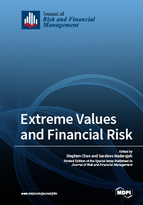Extreme Values and Financial Risk
A special issue of Journal of Risk and Financial Management (ISSN 1911-8074). This special issue belongs to the section "Mathematics and Finance".
Deadline for manuscript submissions: closed (31 December 2017) | Viewed by 61682
Special Issue Editors
Interests: extreme value theory and its applications; distribution theory; nonparametric statistics; information theory; reliability; sampling theory; statistical software; time series
Special Issues, Collections and Topics in MDPI journals
Interests: extreme value analysis and distribution theory in analysing financial commodities data and cryptocurrency data, and financial risk models
Special Issues, Collections and Topics in MDPI journals
Special Issue Information
Dear Colleagues,
Since the 2008 financial crisis, modeling of the extreme values of financial risk has become important. Postgraduate programs, as well as PhD research programs, in mathematical finance are cropping up in nearly every university. Additionally, many conferences are being held annually on the topic of extreme financial risk. The aim of this Special Issue is to provide a collection of papers from leading experts in the area of extreme financial risk. The topics covered in this Special Issue will include, but are not limited to:
- Catastrophic risk
- Drought risk
- Flood risk
- Health risk
- Financial risk
Dr. Saralees Nadarajah
Dr. Stephen Chan
Guest Editors
Manuscript Submission Information
Manuscripts should be submitted online at www.mdpi.com by registering and logging in to this website. Once you are registered, click here to go to the submission form. Manuscripts can be submitted until the deadline. All submissions that pass pre-check are peer-reviewed. Accepted papers will be published continuously in the journal (as soon as accepted) and will be listed together on the special issue website. Research articles, review articles as well as short communications are invited. For planned papers, a title and short abstract (about 100 words) can be sent to the Editorial Office for announcement on this website.
Submitted manuscripts should not have been published previously, nor be under consideration for publication elsewhere (except conference proceedings papers). All manuscripts are thoroughly refereed through a single-blind peer-review process. A guide for authors and other relevant information for submission of manuscripts is available on the Instructions for Authors page. Journal of Risk and Financial Management is an international peer-reviewed open access monthly journal published by MDPI.
Please visit the Instructions for Authors page before submitting a manuscript. The Article Processing Charge (APC) for publication in this open access journal is 1400 CHF (Swiss Francs). Submitted papers should be well formatted and use good English. Authors may use MDPI's English editing service prior to publication or during author revisions.
Benefits of Publishing in a Special Issue
- Ease of navigation: Grouping papers by topic helps scholars navigate broad scope journals more efficiently.
- Greater discoverability: Special Issues support the reach and impact of scientific research. Articles in Special Issues are more discoverable and cited more frequently.
- Expansion of research network: Special Issues facilitate connections among authors, fostering scientific collaborations.
- External promotion: Articles in Special Issues are often promoted through the journal's social media, increasing their visibility.
- e-Book format: Special Issues with more than 10 articles can be published as dedicated e-books, ensuring wide and rapid dissemination.
Further information on MDPI's Special Issue polices can be found here.





